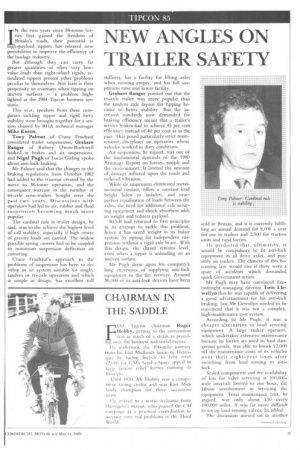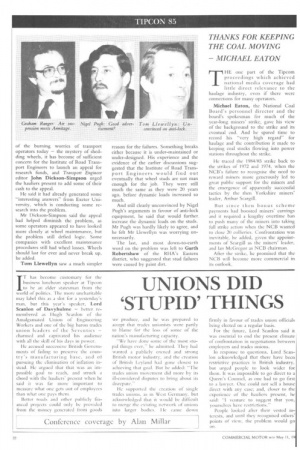NEW ANGLES ON TRAILER SAFETY
Page 23

Page 24

If you've noticed an error in this article please click here to report it so we can fix it.
N the two years since 38-tonne
i lorI
ries first gained the freedom of Britain's roads, their potential as g -payload tippers has released new possibilities to improve the efficiency of the haulage industry.
But although they can carry far greater quantities of often very lowvalue loads than eight-wheel rigids, articulated tippers present other problems peculiar to themselves. Not least is their propensity to overturn when tipping on uneven surfaces — a problem highlighted at the 1984 Tipcon business sessions.
This year, speakers from three companies tackling tipper and rigid lorry stability were brought together for a session chaired by RHA technical manager Mike Kneen.
Tony Palmer of Crane Fruehauf considered trailer suspensions, Graham Ranger of Rubery Owen-Rockwell looked at brakes and air suspensions, and Nigel Pugh of Lucas Girling spoke about anti-lock braking.
Mr Palmer said that the changes in the braking regulations from October 1982 had added to the traumas created by the move to 38-tonne operation, and the consequent increase in the number of tri-axle semi-trailers bought over the past two years. Discussions with operators had led to air, rubber and fluid suspension becoming much more popular.
The cardinal rule in trailer design, he said, was to the achieve the highest level of roll stability, especially if high centre of gravity loads are carried. The widest possible spring centres had to be coupled to minimum suspension deflection on cornering.
Crane Fruehauf's approach to the problems of suspension has been to develop an air system suitable for single, tandem or tri-axle operation and which is simple in design, has excellent roll stiffness, has a facility for lifting axles when running empty, and has full suspension raise and lower facility.
Graham Ranger pointed out that the tri-axle trailer was more popular than the tandem axle layout for tipping because of better stability. But the increased standards now demanded for braking efficiency meant that a trailer's service brakes had to achieve 45 per cent efficiency instead of 40 per cent as in the past. That posed particularly strict maintenance disciplines on operators whose vehicles worked in dirty conditions.
Air suspension, he argued, met one of the fundamental demands of the 1980 Armitage Report on lorries, people and the environment. It limited the amount of damage inflicted upon the roads and reduced vibration.
While air suspension eliminated metalto-metal contact, offers a constant load height laden or unladen, and nearperfect equalisation of loads between the axles, the need for additional axle securing equipment and shock absorbers adds to weight and reduces payload.
RO-R had returned to first principles in its attempt to tackle this problem, hence it has saved weight in its Indair system by opting for independent suspension without a rigid axle beam. With this design, the chassis remains level, even when a tipper is unloading on an uneven surface.
Mr Pugh drew upon his company's long experience of supplying anti-lock equipment to the fire services. Around 30,000 of its anti-lock devices have been sold in Britain, and it is currently fulfilling an annual demand for 8,000 a year for use in trailers and 2,500 for tractive units and rigid lorries.
He predicted that, ultimately, it would be compulsory to fit anti-lock equipment in all drive axles, and possibly on trailers. The chances of this becoming law would rise if there were a spate of accidents which demanded quick Government action.
Mr Pugh may have convinced Leonofreight managing director Tom Llewellyn that he was capable of delivering a good advertisement for his anti-lock braking, but Mr Llewellyn needed to be convinced that it was not a complex, high-maintenance cost system.
According to Mr Pugh, it was a cheaper alternative to load sensing equipment. A large tanker operator, which undertakes extensive maintenance because its lorries are used to haul dangerous goods, was able to knock £2,000 off the maintenance costs of its vehicles over their eight-year lives after switching from load sensing to antilock.
Sealed components and the availability of kits for valve servicing at 100,000mile intervals limited to one hour, the labour involvement in servicing the equipment. Total maintenance cost, he argued, was only about £30 every 100,000 miles. it was far more difficult to set up load sensing valves, he added.
The discussion moved on to another
of the burning worries of transport operators today the mystery of shedding wheels, it has become of sufficient concern for the Institute of Road Transport Engineers to launch an appeal for research funds, and Transport Engineer editor John Dickson-Simpson urged the hauliers present to add some of their cash to the appeal.
He said it had already generated some "interesting answers" from Exeter University, which is conducting some research into the problem.
Mr Dickson-Simpson said the appeal had helped diminish the problem, as some operators appeared to have looked more closely at wheel maintenance, but the problem still defied logic. Some companies with excellent maintenance procedures still had wheel losses. Wheels should last for ever and never break up, he added.
Torn Llewellyn saw a much simpler
reason for the failures. Something breaks either because it is under-maintained or under-designed. His experience and the evidence of the earlier discussions suggested that the Institute of Road Transport Engineers would find out eventually that wheel studs are not man enough for the job. They were still much the same as they were 20 years ago, before dynamic loads increased so much.
And still clearly unconvinced by Nigel Pugh's arguments in favour of anti-lock equipment, he said that would further. increase the dynamic loads on the studs. Mr Pugh was hardly likely to agree, and he felt Mr Llewellyn was worrying unnecessarily.
The last, and most down-to-earth word on the problem was left to Garth Robertshaw of the RHA's Eastern district, who suggested that stud failures were caused by paint dirt.




























































































